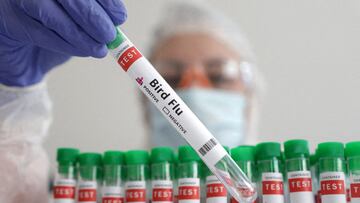Why is extreme heat making it more difficult to control bird flu in Colorado?
The CDC is closely monitoring the situation in Colorado with searing heat contributing to the largest bird flu outbreak among poultry workers ever seen.

A total of eight Colorado farm workers were reported to be infected with bird flu during the past week, more than in any other state, the US Centers for Disease Control (CDC) confirmed. Four of those to have fallen ill were farm workers involved in the depopulation of poultry at a egg-laying facility in Weld County experiencing an outbreak of HPAI H5N1 virus which has been circulating in wild birds and has caused widespread outbreaks in dairy cows in several states. Further cases were reported on Friday.
A substantial percentage of the 1.8 million chickens being killed were infected with the dangerous H5N1 influenza, federal health officials confirmed.
Colorado now home to largest outbreak of human bird flu in U.S. history
— Camus (@newstart_2024) July 20, 2024
The CDC confirmed two more cases Friday, bringing the total to six.
Source: 9NEWS (YouTube) pic.twitter.com/SNi8iMWnCJ
What are the symptoms of the bird flu outbreak in Colorado?
All of the workers who tested positive reported mild illness. Some reported conjunctivitis and eye tearing, as well as more typical flu symptoms of fever, chills, coughing, a sore throat or runny nose. None required hospital treatment and all were administered an oral antiviral agent Tamiflu (oseltamivir).
Temperatures have hovered around 95° F (35° C) since the start of the month - way above the seasonal average (73° F / 23° C) which has been one of the contributing factors to the spread of the HPAI H5N1 virus. It has been too hot for farm workers to wear protective googles and N95 face masks. Industrial fans used to cool the poultry facility ended up spreading the virus through their air.
1. #H5N1 #birdflu in cows update: #USDA reported 3 new herds in Colorado today (Colorado had already reported 2 of them). About 40% of the herds in Colorado have tested positive at this point.
— Helen Branswell 🇨🇦 (@HelenBranswell) July 17, 2024
The cumulative national total is now 161 herds in 13 states. https://t.co/2BioBG0wUw pic.twitter.com/bmg2N9UrQZ
Federal health officials insist that the risk of the general public being infected remains low. However, those who have job-related or recreational exposures to infected birds may be at higher risk of infection and should take appropriate precautions.
Related stories
The HPAI A(H5N1) viruses currently circulating in birds and poultry, with spillover to mammals, and those that have caused human infections do not have the ability to easily bind to receptors that predominate in the human upper respiratory tract.
They added that the genetic sequence of the virus circulating in wild birds and poultry has not changed substantially since December, according to ongoing surveillance progam conducted by the Animal and Plant Health Inspection Service (APHIS). Nor have there been any signs of unexpected increases in flu activity in Colorado, or in other states affected by bird flu.


Complete your personal details to comment